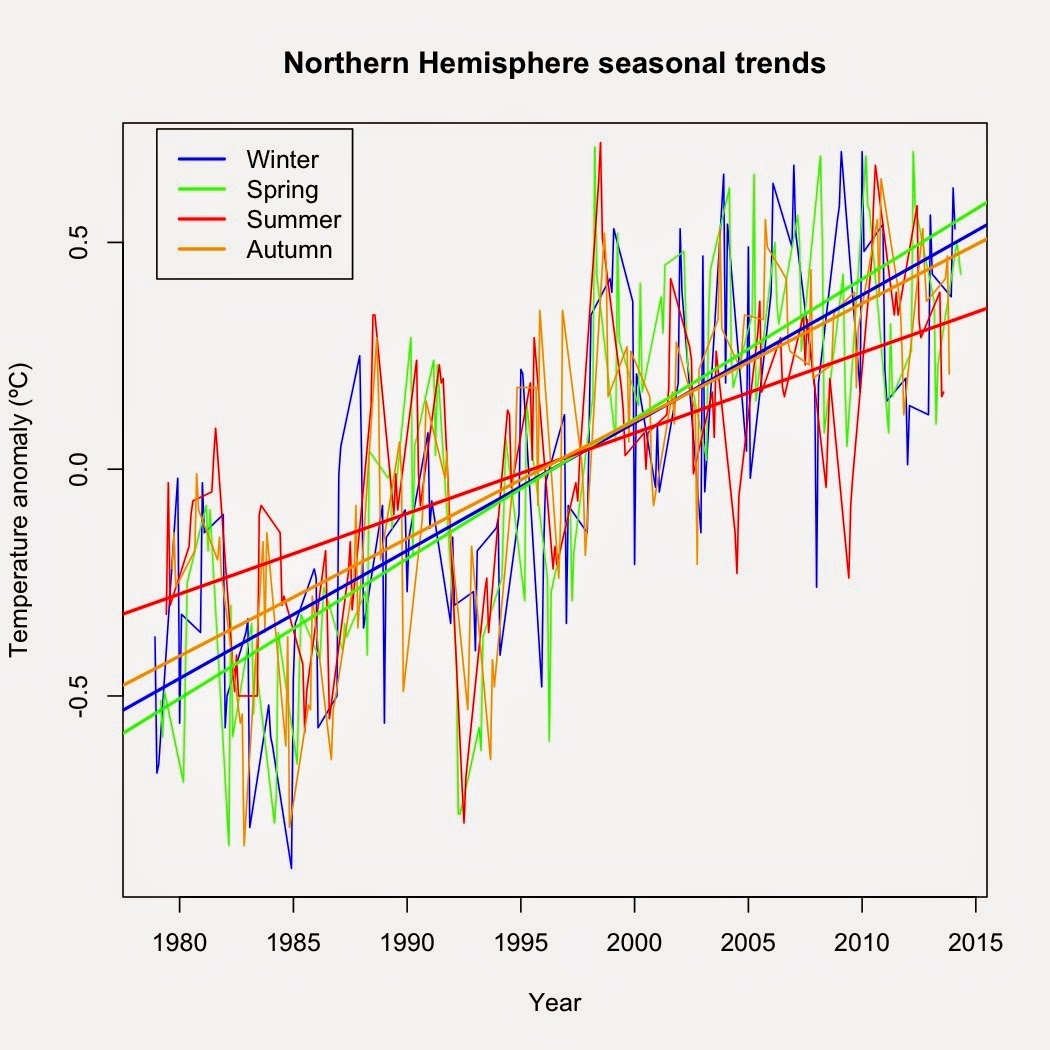Seasonal trends by hemisphere
A reader raised a good question about my last post. One of the confirmed predictions of climate change is that winters will warm faster than summers, yet my analysis showed that December-February warmed the least. The question was why that would be. The answer is simple: I used global temperature data. December-February may be winter in the Northern Hemisphere but it is summer in the Southern. The seasons largely cancel out. The reason we see faster warming in the June-August (Northern Hemisphere summer) versus December-February (Southern Hemisphere summer) is due to the position of land masses. There's a greater proportion of ocean in the Southern Hemisphere and the ocean doesn't change temperature very readily compared to landmasses whereas the Northern Hemisphere has more landmass and consequently a larger response to seasonal changes in insolation.
To see whether or not winters are truly warming faster than the summers, you must use mid- to upper-latitude areas of each hemisphere. The low-latitudes (i.e. tropics) don't experience much of a seasonal difference. I'm going to use UAH satellite data, as it breaks down the monthly average temperatures of different regions of the planet, including the mid- to high-latitudes. Looking at the Northern Hemisphere mid- and high-latitudes (labeled NoExt in the dataset), we see the following:
The trends for each season are as follows:
Northern Hemisphere winters have warmed at a 0.281ºC/decade clip whereas summers have "only" warmed at a 0.176ºC/decade rate, the slowest warming rate of all the seasons. Also interesting is the warming rates of the spring and autumn, both very similar to that of winter.
In the Southern Hemisphere mid- to high-latitudes (SoExt in the UAH data), you find the following pattern:
The trends for each season are:
Again, winters warm faster than the summers. In fact, the summers and autumns in the Southern Hemisphere haven't shown any statistically significant warming at all. In the Southern Hemisphere, only winter and spring show any statistically significant warming since 1979.
So what to made of all this? In both hemispheres, winter temperatures have warmed faster than summer temperatures, thereby confirming the prediction. Spring temperatures have warmed the fastest in both hemispheres whereas autumn temperatures are mixed between the two hemispheres.
To see whether or not winters are truly warming faster than the summers, you must use mid- to upper-latitude areas of each hemisphere. The low-latitudes (i.e. tropics) don't experience much of a seasonal difference. I'm going to use UAH satellite data, as it breaks down the monthly average temperatures of different regions of the planet, including the mid- to high-latitudes. Looking at the Northern Hemisphere mid- and high-latitudes (labeled NoExt in the dataset), we see the following:
The trends for each season are as follows:
| Winter | 0.281ºC/decade | ± 0.059ºC/decade |
| Spring | 0.306ºC/decade | ± 0.077ºC/decade |
| Summer | 0.176ºC/decade | ± 0.090ºC/decade |
| Autumn | 0.255ºC/decade | ± 0.063ºC/decade |
Northern Hemisphere winters have warmed at a 0.281ºC/decade clip whereas summers have "only" warmed at a 0.176ºC/decade rate, the slowest warming rate of all the seasons. Also interesting is the warming rates of the spring and autumn, both very similar to that of winter.
In the Southern Hemisphere mid- to high-latitudes (SoExt in the UAH data), you find the following pattern:
The trends for each season are:
| Winter | 0.115ºC/decade | ± 0.036ºC/decade |
| Spring | 0.177ºC/decade | ± 0.073ºC/decade |
| Summer | 0.053ºC/decade | ± 0.060ºC/decade |
| Autumn | 0.037ºC/decade | ± 0.055ºC/decade |
Again, winters warm faster than the summers. In fact, the summers and autumns in the Southern Hemisphere haven't shown any statistically significant warming at all. In the Southern Hemisphere, only winter and spring show any statistically significant warming since 1979.
So what to made of all this? In both hemispheres, winter temperatures have warmed faster than summer temperatures, thereby confirming the prediction. Spring temperatures have warmed the fastest in both hemispheres whereas autumn temperatures are mixed between the two hemispheres.





Comments
Post a Comment